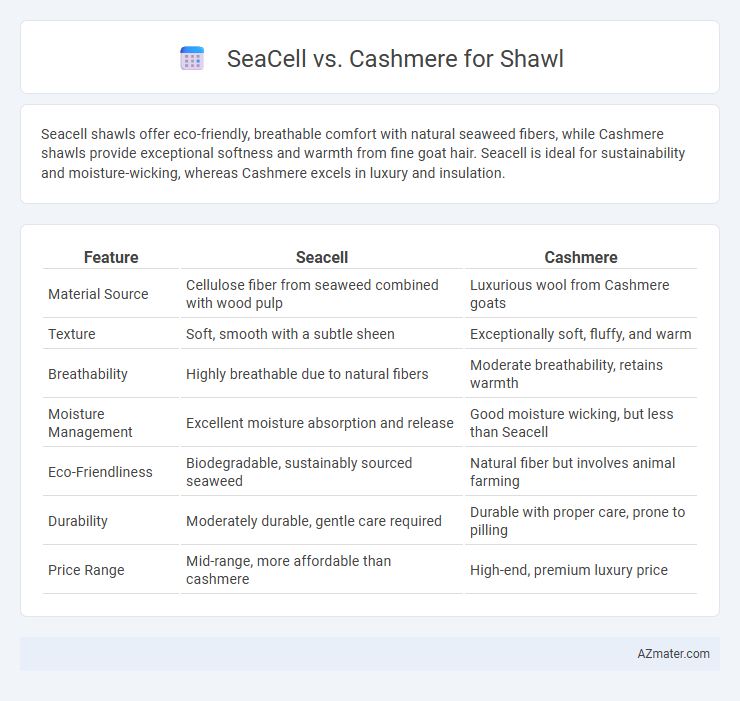Seacell shawls offer eco-friendly, breathable comfort with natural seaweed fibers, while Cashmere shawls provide exceptional softness and warmth from fine goat hair. Seacell is ideal for sustainability and moisture-wicking, whereas Cashmere excels in luxury and insulation.
Table of Comparison
| Feature | Seacell | Cashmere |
|---|---|---|
| Material Source | Cellulose fiber from seaweed combined with wood pulp | Luxurious wool from Cashmere goats |
| Texture | Soft, smooth with a subtle sheen | Exceptionally soft, fluffy, and warm |
| Breathability | Highly breathable due to natural fibers | Moderate breathability, retains warmth |
| Moisture Management | Excellent moisture absorption and release | Good moisture wicking, but less than Seacell |
| Eco-Friendliness | Biodegradable, sustainably sourced seaweed | Natural fiber but involves animal farming |
| Durability | Moderately durable, gentle care required | Durable with proper care, prone to pilling |
| Price Range | Mid-range, more affordable than cashmere | High-end, premium luxury price |
Introduction: Seacell and Cashmere Shawls
Seacell shawls combine sustainable seaweed fibers with soft cotton to offer natural breathability, moisture regulation, and antioxidant properties ideal for sensitive skin. Cashmere shawls, made from the luxurious undercoat of cashmere goats, provide unparalleled warmth, softness, and lightweight comfort, making them a classic choice for premium winter accessories. Both materials deliver distinct benefits for shawl wearers seeking either eco-friendly innovation or traditional luxury.
What is Seacell?
Seacell is a sustainable fiber made from natural seaweed and cellulose, known for its breathability, moisture-wicking, and skin-soothing properties, making it ideal for shawls worn close to the skin. Compared to cashmere, Seacell offers enhanced eco-friendly benefits and natural antioxidants that support skin health. While cashmere provides unparalleled softness and warmth, Seacell shawls combine comfort with functional wellness and environmental sustainability.
What is Cashmere?
Cashmere is a luxury fiber obtained from the undercoat of Cashmere goats, renowned for its exceptional softness, warmth, and lightweight feel, making it one of the most desirable materials for shawls. Its fine fibers are about 14-19 microns in diameter, which is significantly thinner than sheep wool, allowing for superior insulation without bulk. Cashmere shawls are prized for their durability, breathability, and natural moisture-wicking properties, offering both comfort and elegance for cold weather wear.
Fiber Properties: Seacell vs Cashmere
Seacell fiber, derived from cellulose and infused with seaweed, offers exceptional breathability, moisture absorption, and natural antibacterial properties, making it ideal for sensitive skin and long wear. Cashmere, sourced from the undercoat of cashmere goats, is prized for its ultra-fine fibers, providing unmatched softness, warmth, and lightweight insulation. While Seacell excels in sustainability and skin health benefits, Cashmere remains superior in luxurious softness and thermal insulation for high-end shawls.
Softness and Comfort Compared
Seacell shawls offer exceptional softness due to their fine cellulose fibers blended with natural seaweed, providing a smooth and breathable texture ideal for sensitive skin. Cashmere shawls are renowned for their luxurious softness, derived from the ultra-fine undercoat of Cashmere goats, delivering superior warmth and a plush feel. While Cashmere excels in warmth and a velvety touch, Seacell provides enhanced moisture management and hypoallergenic properties, making both excellent choices for comfort depending on wearer preference.
Sustainability and Eco-Friendliness
Seacell fibers, derived from sustainably harvested seaweed and wood pulp, offer natural biodegradability and skin-nourishing properties, making them an eco-friendly choice for shawls. Cashmere, sourced from the undercoat of cashmere goats, raises sustainability concerns due to overgrazing and land degradation in production regions, impacting ecosystems negatively. Choosing Seacell over traditional cashmere supports reduced environmental footprint through renewable raw materials and less resource-intensive processing in shawl production.
Care and Maintenance Differences
Seacell shawls require gentle hand washing in cold water with mild detergent to preserve the fiber's skin-friendly properties, avoiding bleach and harsh chemicals to maintain softness. Cashmere shawls demand careful hand washing or dry cleaning, with emphasis on using specialized wool detergents and drying flat to prevent stretching and pilling. Both materials benefit from storing in breathable bags away from direct sunlight to extend shawl longevity and maintain fiber integrity.
Allergies and Skin Sensitivity
Seacell fibers are infused with seaweed extracts that provide natural anti-inflammatory and hypoallergenic properties, making them ideal for sensitive skin and allergy sufferers. Cashmere, while exceptionally soft, can sometimes cause irritation or allergic reactions due to lanolin content and the fine animal fibers. Choosing Seacell for shawls supports skin comfort and reduces the risk of itchiness or redness for users with allergic tendencies.
Price Point and Value
Seacell shawls are priced moderately, offering a unique blend of sustainable seaweed fibers and softness that enhances skin health, making them a valuable choice for eco-conscious consumers. Cashmere shawls command a higher price point due to their luxurious, ultrafine wool and exceptional warmth, representing premium quality and timeless elegance. Choosing between Seacell and Cashmere depends on budget priorities and desired benefits, with Seacell delivering innovative comfort at a lower cost and Cashmere providing unmatched luxury and durability.
Choosing the Best Shawl Material
Seacell and cashmere both offer luxurious options for shawl materials, but each has unique benefits tailored to different needs. Seacell fabric, infused with seaweed fibers, provides natural moisture-wicking properties and eco-friendly sustainability, ideal for those seeking comfort and environmental responsibility. Cashmere, known for its exceptional softness and warmth, excels in insulation and durability, making it the best choice for premium, cozy shawls in colder climates.

Infographic: Seacell vs Cashmere for Shawl
 azmater.com
azmater.com